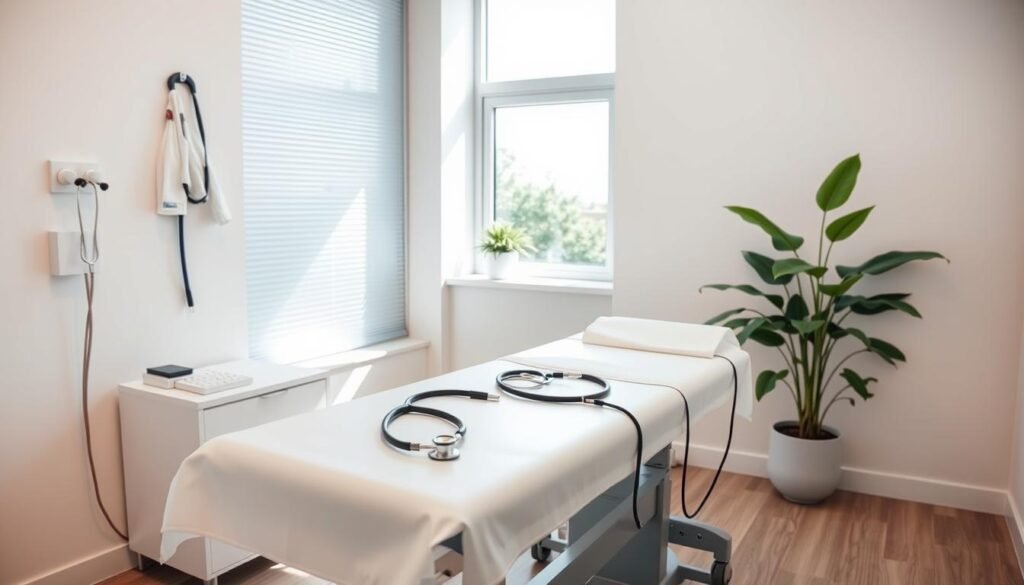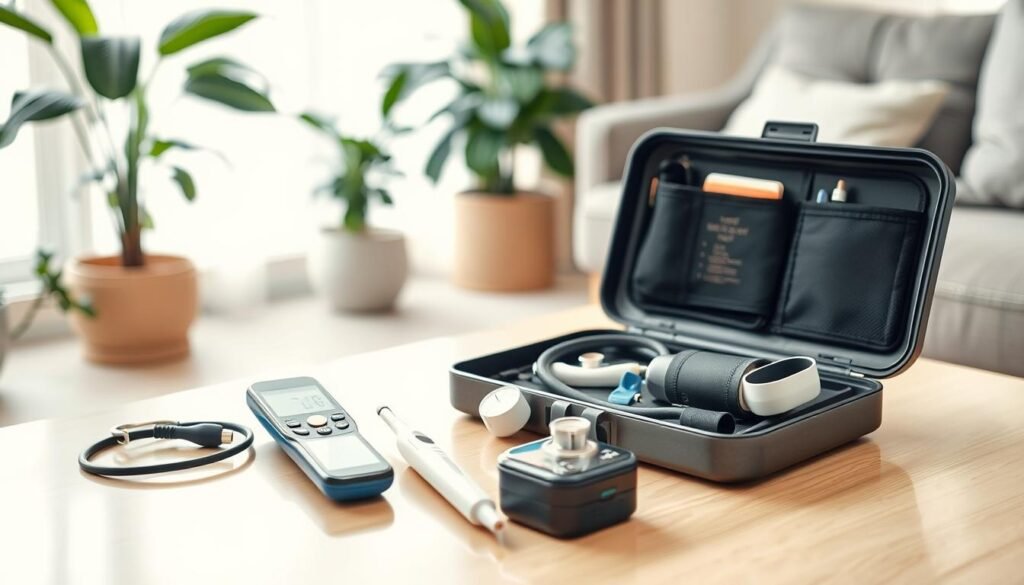Did you know nearly 70% of chronic diseases can be stopped early? This fact shows how important it is to keep an eye on your health. By looking out for the first signs of trouble, you can stop big problems before they start. People can live better lives by using health checks in everyday life.
Even small changes can make a big difference. Checking your heartbeat or using new health gadgets can start you on a path to good health. These steps are easy ways to keep healthy and prevent diseases.
Key Takeaways
- Regular blood pressure checks can help manage and understand health conditions.
- Weighing yourself consistently can highlight fluctuations that may signal health concerns.
- Using pulse oximeters can facilitate early symptom detection for heart issues.
- Monitoring body temperature and breathing rates can provide essential insights into health status.
- Fitness trackers are valuable tools for keeping tabs on vital signs and health metrics.
- Open discussions with healthcare providers about monitored data can promote timely interventions.
Understanding the Importance of Early Detection
Finding health issues early is key to better treatment. It allows doctors to act fast, leading to easier treatments and better health. For example, early screening can catch cervical cancer before it gets worse. This early action can stop the cancer from progressing further.
Preventive health is vital in catching diseases early. Screenings help catch diseases before they become serious. However, not all screenings are for everyone. The World Health Organization says some, like mammograms, are better for certain ages. But targeted screenings can make a big difference in recovery. Education plays a big role in teaching about early symptoms and the need for quick doctor visits.
Sometimes, people can’t get to healthcare easily or don’t know about these issues. Community programs are important. They teach people about the benefits of early detection. This not only saves money on healthcare but also makes life better.
| Aspect | Impact of Early Detection |
|---|---|
| Treatment Invasiveness | Less invasive options available |
| Recovery Rates | Higher likelihood of successful outcomes |
| Treatment Costs | Generally lower than advanced disease management |
| Quality of Life | Significantly improved |
How to Monitor Your Health for Early Signs
Watching your health can help find early signs of potential problems. It’s better to be proactive about your well-being. To spot health issues early, watch for new or changing symptoms.
Recognizing Early Warning Signs of Health Issues
Knowing your health means noticing even small changes. These include:
- Persistent fatigue or lack of energy
- Unusual weight changes
- Mood fluctuations or emotional disturbances
- Abnormal body temperature, which may indicate infection or illness
A normal body temperature is around 98.6°F. Differences can mean health problems. You should also know your resting heart rate and how many times you breathe per minute. Keeping track of these can alert you to health concerns early on.
The Role of Preventive Health Measures
Staying on top of your health can prevent many issues. Regular checks and screenings catch problems early. Blood pressure measures, for example, show if your heart is healthy. The American Heart Association suggests monitoring blood pressure at home if you have high blood pressure. It’s good to take readings daily and record them.
By adopting preventive measures, you highlight the value of knowing health signs. This encourages you to take active steps in caring for your health.
Health Monitoring Techniques You Can Implement
Keeping track of our health has gotten easier with many techniques. Now, we blend high-tech with traditional ways to watch over our health. This mix helps us catch health issues early and take action.
Utilizing Technology for Health Surveillance
New technology has changed health monitoring a lot. For example, gadgets like remote patient monitoring systems help us get a real-time look at our health. This helps doctors make better choices earlier. Blood pressure monitors at home are key for people with high blood pressure.
Glucometers help those with diabetes keep an eye on their sugar levels. And, wearable devices like fitness trackers show how our daily activities affect our health. They reveal how different actions can either help or harm our well-being.
Traditional Methods of Self-Health Assessment
Even with all the tech, old-school health checks are still important. For example, checking the color and smell of urine can tell us a lot about hydration. Women can do monthly breast self-exams to spot any unusual changes sooner. Men should also do self-checks for testicular health.
Exercises like balance tests and looking at hair health provide clues about our overall health. These simple tests can highlight important signs of our health. They make talking to doctors more effective.
The Significance of Regular Physical Exams
Regular physical exams are key to staying healthy. They catch health issues early, so you can avoid bigger problems later. At these exams, doctors check your vital signs, look at your health history, and may do some lab tests just for you.
What to Expect During Your Check-Up
Your yearly check-up will be thorough. You’ll go through several steps:
- Reviewing medical history
- Measuring vital signs, like blood pressure and heart rate
- Checking your body’s different parts
- Recommending tests you might need
- Updating your shots
- Talking about how your lifestyle affects your health
These exams help find problems you might not know about. For example, you could have high blood pressure or cholesterol without any signs. Finding these issues early can help you get the right treatment.
Communicating Effectively with Healthcare Providers
Talking well with your doctor makes physical exams more useful. You should say what’s on your mind, like any health worries or changes you’ve noticed. This helps you and your doctor work together better. You’ll figure out what tests you need and how to stay healthy.
- Telling your doctor about any symptoms or concerns
- Sharing your family’s health history
- Talking about your lifestyle
- Asking about different ways to get better
Good communication helps you understand your health better. It also makes sure you’re doing everything you can to stay well. It highlights the importance of seeing your doctor regularly.

Understanding Health Indicators
Understanding health indicators is crucial for good health monitoring. These include things like vital signs and test results. They help us spot health problems early. For example, tracking your blood pressure, cholesterol, and body mass index is key. Noticing changes in these can help you manage your health better. This may mean getting medical help early or changing your lifestyle.
In 2014, the Global Fund watched diseases like AIDS, tuberculosis, and malaria. They used 114 health indicators. The Sustainable Development Goals (SDGs) now set 17 goals with 232 health-related indicators for 2030. Out of these, 13 goals focus on health conditions. This shows how important these indicators are in checking how well health systems are doing.
Countries track many health indicators. The World Health Organization says some track up to 600 indicators. These can be hard to compare because they differ in definitions and how often they are measured. Splitting them by socio-economic factors makes gathering and analyzing data even tougher.
Good data, clear definitions, and the ability to split data into groups make health monitoring better. Indicators should match government health goals to highlight major public health issues. They can also measure how well services cover needs. This is often done using proxy indicators when direct data isn’t available.
Monitoring things like how many adults get colorectal cancer screenings helps shape community health plans. Keeping up with these indicators helps everyone be more involved in their health care. Knowing about health indicators leads to smarter health decisions. It can improve health outcomes and overall well-being. For more information on spotting health issues early, check out this resource.
Essential Vital Signs to Monitor at Home
Checking your vital signs at home is a smart move. It can tell you a lot about your health. You can use simple tools to keep an eye on your blood pressure, weight, pulse, and temperature. Doing this on the regular aids in catching problems early and managing your health better.
Blood Pressure: Tracking Your Numbers
Tracking blood pressure is key, especially for people with high blood pressure. It’s important to measure it often to see any changes or how well treatments are working. A normal reading is below 120/80 mm Hg. If it’s 130/80 mm Hg or more, that’s high blood pressure. This condition can cause big health issues if ignored. Monitoring at home helps doctors keep a close eye on your blood pressure every day. For tips on how to keep track of your blood pressure, look into expert advice.
Weight Management: A Key Indicator of Health
Keeping an eye on your weight is crucial for good health. Checking it regularly can show any big changes, which could mean health problems. You should weigh yourself once a week and talk to a doctor if you see any big differences. Staying at a healthy weight can lower your risk of long-term illnesses. This shows why weight is so important to watch.
Measuring Pulse and Heart Rate Effectively
Checking your pulse gives you important info about your heart’s health. For most adults, a good resting pulse rate is between 60 to 100 beats per minute. Keeping track of your pulse can point out heart rhythm issues or other heart concerns. Tools like heart rate monitors or pulse oximeters make it simple to notice any big changes in your heart rate.
Temperature and Breathing Rate Observations
Monitoring your temperature is key to understanding your health. A normal adult body temperature is usually between 97.8 and 99.1 degrees Fahrenheit. If it’s over 100.4 degrees Fahrenheit, that might mean you have a fever. Also, it’s critical to keep an eye on how fast you breathe. A healthy rate is 12 to 18 breaths a minute. If you breathe less than 12 or more than 25 times a minute, you could have breathing problems. Knowing these numbers helps you get help and advice when you need it.

Keeping Track of Your Health Records
Keeping an eye on your health records is key to staying healthy. A good system for your health records lets you check your medical info easily. This helps you take care of yourself and talk better with doctors.
The Importance of Personal Health Records (PHR)
Having your health records helps you know your health history well. People with PHRs often get better, especially if they have long-term illnesses. Having your records, like family health history and doctor visit summaries, is very important. For example, about 40 percent of people with blood pressure medicine can’t name their meds. This shows why keeping good records is needed to make smart health choices and follow treatments.
What to Include in Your Health Record
Your health record should have many important details:
- Medications: A full list, including how much and for how long
- Medical History: Info on past sicknesses or operations
- Symptoms and Responses: Notes about symptoms, side effects, and how you reacted to medicine, especially for ongoing conditions
- Doctor Visit Summaries: Short updates or thoughts from each visit
- Test Results: Copies of lab work and other tests
- Legal and Insurance Documents: Papers about your health insurance and legal rights
Technology really helps with keeping track of your health info. Many doctors offer online tools to view your health records easily. For example, MyChart by Johns Hopkins makes it easy to talk to your doctors. You can ask for more medicine or set up visits. Always keep your records up to date, especially after big health events.
| Health Record Component | Purpose |
|---|---|
| Medications | Helps track prescriptions and avoid potential interactions |
| Medical History | Provides context for treatment decisions and risk assessments |
| Symptoms and Responses | Aids in identifying patterns and tailoring treatments |
| Doctor Visit Summaries | Ensures continuity of care and informs future consultations |
| Test Results | Enables monitoring of progress and response to treatment |
| Legal and Insurance Documents | Safeguards rights and ensures appropriate coverage |
Taking time to start and keep your health records up to date is smart. It makes talking to doctors better and helps you make informed health choices.
Improving Your Lifestyle for Better Health
To get healthier, we need to make smart choices about what we eat and how much we move. Eating better can really help us feel good. Also, moving more is key to a healthy life. These steps can make us happier and healthier for a long time.
Nutrition: Making Healthier Food Choices
Eating well can make you feel awesome. Filling up on fruits, veggies, whole grains, and lean meats is great for energy and keeping a good weight. Try to eat less junk food and sugar, and pick natural foods instead. Here are some easy swaps to make:
- Replace white bread with whole grain for added fiber.
- Choose skinless chicken instead of fried alternatives.
- Snack on almonds or fruit instead of candy.
Exercise: Incorporating Physical Activity Into Daily Life
Making exercise a regular part of your life is important. The experts say adults should aim for 150–300 minutes of aerobic exercise each week. Doing workouts that make your muscles stronger is also a good idea.
Even small changes help. Why not take the stairs instead of the elevator? It can help you hit 10,000 steps a day. Exercise is great for keeping your weight in check, helping your heart, cutting stress, and making you feel happy.

| Health Aspect | Recommended Guidelines |
|---|---|
| Exercise | 150–300 minutes of moderate-intensity or 75 minutes of vigorous activity weekly |
| Alcohol Intake | No more than one drink per day for women; one to two for men |
| Hydration | 8 to 13 cups of water daily |
| Sleep | 7 to 9 hours of quality sleep nightly |
| Weight Management | Maintain a healthy weight with BMI and waist circumference checks |
Self-Care Health Tips for Effective Wellness
Self-care is key for your mental and physical health. It helps you stay well and balanced in life’s daily challenges.
Prioritizing Sleep for Overall Well-Being
Getting enough sleep is a must for staying healthy. Adults need seven to eight hours each night. Research indicates not sleeping enough can lead to heart disease, diabetes, and depression. Making sleep a priority helps with thinking, mood, and health. Try to follow a regular bedtime routine and make your bedroom a calm space for better sleep.
Managing Stress to Enhance Health
Handling stress well is crucial for your health. Techniques like meditation, yoga, and tai chi lower stress and improve your mood. These practices make it easier to deal with health problems.
Talking with family and friends builds a strong support network. It gives you a sense of purpose and happiness. You can find great stress help by visiting this link.
Additional Wellness Monitoring Strategies
Effective wellness monitoring ups overall well-being. It also helps with proactive health management. People can use several methods to keep an eye on their health, making it simpler to spot areas needing work.
Utilizing Fitness Trackers for Active Monitoring
Fitness trackers are a fun way to keep tabs on health stats. They log your daily move, heartbeat, and sleep habits. This gives a full view of your health. By setting personal goals, you can observe your progress in real time. This encourages a more lively way of life.
Understanding the Benefits of Muscle Maintenance
Keeping muscles in good shape is key for all ages. Doing strength exercises, at least two times a week, is essential. It helps keep muscle mass as you get older. Strong muscles mean better balance, fewer injuries, and better health. Adding these exercises to your daily life brings lasting health gains.
Conclusion
The path to better health starts with watching our health closely and spotting early signs of trouble early. People are getting better at noticing when something with their health is off. This means they can take steps early to stop things from getting worse. Whether using new tech or old methods, staying in touch with our health is key to staying well.
It’s super important to have regular check-ups and keep an eye on important health numbers. Research shows that those who do this tend to have better health results. This active approach is good for our health and helps everyone realize how crucial it is to watch our health closely. Knowing what our health numbers mean and using resources wisely is vital. This was shown in studies on hospital monitoring and how spotting early signs can alert us to health problems.
Choosing to manage our health well can lead to a happier and healthier life. By learning and taking action, communities can bring positive changes and encourage everyone to look after their health. Tracking our health not only gives us the information needed for good health but also creates a supportive atmosphere. For more on spotting early signs and why monitoring is key, check out important health indicators and the impact of watching vital signs in health research.